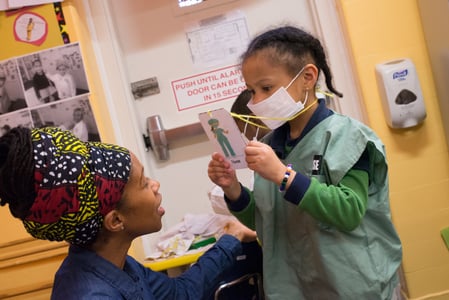
I’d like you to take a minute and think about the answers to the following questions:
- Why do you write out a shopping list before you go to the grocery store each week?
- Why do you scramble to do 3 loads of laundry on a Sunday night just before the week begins?
- Why do you spend time writing out lesson plans to submit to your Director at the beginning of the month?
- What is the purpose of balancing your checkbook each month?
Chances are, you know the answers to these questions, and have very good reasons for why you do the things that you do. Unless you are a very rare breed that enjoys doing laundry, you probably rush to get the laundry done so that you will have clean clothes to wear. We all have a purpose or a reason for doing the things that we do, and we know why we do them.
Now, picture this classroom activity: some children are working with unifix cubes at a table. They are putting them together to make different types of patterns. The educator walks up to one of the children and asks, “What are you doing?” and “Why are you doing that?”
Would the children in the classroom be able to answer those questions?
Clarity of Learning Objectives
Most of the time, educators have very good reasons for why they are doing certain activities in a classroom. They know that if they want the children to learn about different types of weather, they might read books about weather. The children might create a weather graph in the classroom to graph the number of sunny, cloudy, rainy, and windy days. Or walk outside to observe what the weather is like, and paint pictures to show different types of weather. The educator knows the purpose, or the objective, of the lesson. But do the children know why they are doing these types of activities and what they will learn by doing them?
In the Instructional Learning Formats dimension in the Pre-K CLASS® tool, one of the indicators is Clarity of Learning Objectives. I often get asked about this particular indicator and to further explain what it is. Basically, this indicator means that the educator effectively focuses children’s attention on the learning objectives and/or the purpose of the lesson. Students in the classroom appear aware of the point of the lessons or how they should focus their attention during activities.
How Can Educators Use Clarity of Learning Objectives in the Classroom?
Let's talk about how an educator might implement Clarity of Learning Objectives in their classroom:
- Advanced organizers: The educator might frequently use strategies such as advanced organizers. For example, before reading a story about farm and zoo animals, they might say, “Let’s look through the pictures in this book before we read it and see if we can find all the different animals that we will talk about today.” They're giving the children a direction, or a focus, which is identifying different animals.
- Summaries: Once a lesson is complete, the educator can use summary statements to wrap up what was just learned. For example, after reading the book about the animals, they might say, “So we just talked about how farm and zoo animals are different.” Summaries can be short, concise phrases that simply reiterate what the objective of the activity was.
- Reorientation statements: When students need a reminder of what the focus of the activity is, the educator may need to use reorientation statements to draw their attention back to the learning objective. For example, “We are getting a bit off track; let’s make sure we are thinking about the differences between farm and zoo animals—not what a zoo is.”
This seems easy enough when the educator has determined the learning objective and the activity. But how do they do this during centers when the child has chosen the activity? During centers, they should focus their questions on the activity in which the student is involved.
For example, when children are using different-size squeeze bottles and scoops at the water table, they can ask them how they are going to fill the bottles or which bottles will get filled faster. In addition, they may ask them questions about what lives in the water.
The next time you are in a classroom, take a minute to reflect upon this statement: “Do the children in my classroom know why we are doing this activity or lesson, and what will they learn by doing it?"
For a free downloadable resource, click HERE.

